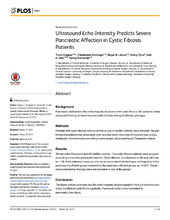Ultrasound echo-intensity predicts severe Pancreatic affection in cystic fibrosis patients
Engjom, Trond; Erchinger, Friedemann Georg; Lærum, Birger Norderud; Tjora, Erling; Gilja, Odd Helge; Dimcevski, Georg Gjorgji
Peer reviewed, Journal article
Published version

View/
Date
2015-03-24Metadata
Show full item recordCollections
Original version
https://doi.org/10.1371/journal.pone.0121121Abstract
Background: Pancreatic destruction affects the majority of patients with cystic fibrosis. We aimed to relate ultrasound findings to exocrine pancreatic function and cystic fibrosis genotype. Methods: Patients with cystic fibrosis and a matched group of healthy controls were included. We performed transabdominal ultrasound, and recorded echo intensities of the pancreas and parenchymal characteristics according to endoscopic ultrasound based Rosemont criteria. Results: We included 39 patients and 29 healthy controls. The cystic fibrosis patients were grouped according to exocrine pancreatic function; Cystic fibrosis, insufficient (n = 20) and sufficient (n = 19). Echo intensity measures and visual score demonstrated hyper-echogenicity in the pancreas insufficient group compared to the pancreas sufficient groups (p<0.001). Ductal and parenchymal changes were not prevalent in any of the groups. Conclusion: The hyper-echoic pancreas was the most frequent ultrasonographic finding in exocrine pancreas insufficient cystic fibrosis patients. Pancreatic echo levels correlated to pancreatic phenotype.
